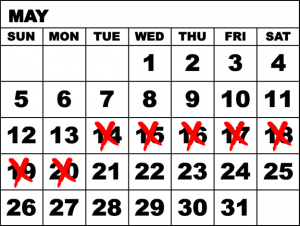Coordinators
This description of worker’s compensation coordinator duties and responsibilities provides a general overview and reference. Your campus may allocate specific tasks and responsibilities in a different manner.
After your initial actions to start the claim process, there are a variety of other tasks that you will need to handle.
Contact and communication
You will need to provide information and talk to the injured employee about the worker’s compensation program and the worker’s rights and responsibilities. Also, provide the injured employee with benefit information regarding their medical bills, mileage reimbursement, accrued leave restoration and any other Worker’s Compensation information.
Stay in regular contact with the employee (claimant), supervisor, and Claims Examiner throughout the claim process. Regularly update the injured worker and his/her supervisor on the status of the claim and potential for returning to work.
Obtain any missing information needed from the injured worker to expedite the claim such as restrictions, lost time.
Keep the Claims Examiner at UW System Administration apprised of any problems with the claim, investigate the circumstances of each claim and, on request of the claims examiner, coordinate specific investigations and assist with internal and formal investigations.
Enter and maintain OSHA recordkeeping
Determine the OSHA recordable status of the claim and enter your decision within seven (7) days of when the injury/illness was first reported. Detailed assistance with this is available on our OSHA recordable decisions webpages.
Lost and restricted days are calculated and maintained per recordkeeping requirements. For more detail, see our guidance sheet, .
OSHA 300A form must be posted February 1 to April 30 of each year for the prior year’s injuries and illnesses. The OSHA 300 needs to be printed and stored for at least the current year, plus seven prior years (per State Risk Management Record Retention Schedule).
Note: UWSA is responsible for providing data to Bureau of Labor Statistics and Wisconsin Department of Safety and Professional Services.
Documents and forms — Obtain, process, and review
Obtain, process, and review documents and forms as needed by the case.
- Safety Coordinator’s Review and any supplemental safety review forms
- Internal forms necessary for lost time benefits management
- Return to work documentation
- Medical releases, bills, and notes
- Other related letters or correspondence
Review all documents to identify any irregularities, (e.g., treatment not related to the work injury) and notify the UWSA claims examiner of your findings.
Forward the original documents to the UWSA claims examiner in a timely manner for processing.
Medical bills forwarded to UWSA will be evaluated for reasonable and necessary medical treatment related to the work injury. If medical notes are not submitted with bills, payment maybe delayed. UWSA will correspond with the physician or provider to clarify any billing matter. Approved bills are forwarded to a medical bill audit vendor for bill review, and processing for standard and customary billing.
Coordinate campus return to work efforts
Coordinate campus return to work efforts by obtaining return to work forms from the treating physician.
Contact the employee’s supervisor to assure understanding of any necessary accommodations and to identify suitable transitional work for the injured employee.
Notify the employee of the return to work agreement.
Correspond with the physician to clarify employer related concerns.
Recordkeeping
Maintain campus records on each claim according to your campus guidelines; UW System Administration advises that you keep the campus file for at least 7 years.
UW System Administration is the official record custodian and claims are kept according to the Risk Management General Record Schedule; 30 years from the last date of compensation.
In occupational disease claims there may be no statute of limitations.
Hazardous duty processing
An employee in a protective service occupation may be eligible for hazardous duty pay. If the employee is injured while performing a hazardous duty (i.e. protecting property, process of making an arrest, etc.), they can receive full base pay with no use of leave credits. Please refer to UW System Administrative Policy 1231 Hazardous Employment Benefits for more information.
When an employee is eligible for Hazardous Duty pay, the coordinator should request that the employee and supervisor complete the “Leave of Absence with Pay Due to Injury” form (Appendix 2). Final approval of eligibility is determined by Employment Relations Chief Director at each campus. The coordinator should forward the completed form to the UWSA claims examiner.
Submission of all other forms and procedures are followed as if this is a lost time claim.
